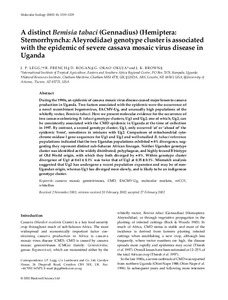| dc.contributor.author | Legg, J.P. |
| dc.contributor.author | French, R. |
| dc.contributor.author | Rogan, D. |
| dc.contributor.author | Okao‐Okuja, G. |
| dc.contributor.author | Brown, J. |
| dc.date.accessioned | 2019-12-04T11:21:26Z |
| dc.date.available | 2019-12-04T11:21:26Z |
| dc.date.issued | 2002 |
| dc.identifier.citation | Legg, J., French, R., Rogan, D., Okao‐Okuja, G. & Brown, J. (2002). A distinct Bemisia tabaci (Gennadius)(Hemiptera: Sternorrhyncha: Aleyrodidae) genotype cluster is associated with the epidemic of severe cassava mosaic virus disease in Uganda. Molecular Ecology, 11(7), 1219-1229. |
| dc.identifier.issn | 0962-1083 |
| dc.identifier.uri | https://hdl.handle.net/20.500.12478/3780 |
| dc.description.abstract | During the 1990s, an epidemic of cassava mosaic virus disease caused major losses to cassava production in Uganda. Two factors associated with the epidemic were the occurrence of a novel recombinant begomovirus, EACMV-Ug, and unusually high populations of the whitefly vector, Bemisia tabaci. Here we present molecular evidence for the occurrence of two cassava-colonizing B. tabaci genotype clusters, Ug1 and Ug2, one of which, Ug2, can be consistently associated with the CMD epidemic in Uganda at the time of collection in 1997. By contrast, a second genotype cluster, Ug1, only occurred 'at' or 'ahead of' the epidemic 'front', sometimes in mixtures with Ug2. Comparison of mitochondrial cytochrome oxidase I gene sequences for Ug1 and Ug2 and well-studied B. tabaci reference populations indicated that the two Ugandan populations exhibited approximately 8% divergence, suggesting they represent distinct sub-Saharan African lineages. Neither Ugandan genotype cluster was identified as the widely distributed, polyphagous, and highly fecund B biotype of Old World origin, with which they both diverged by approximately 8%. Within genotype cluster divergence of Ug1 at 0.61 +/- 0.1% was twice that of Ug2 at 0.35 +/- 0.1%. Mismatch analysis suggested that Ug2 has undergone a recent population expansion and may be of nonUgandan origin, whereas Ug1 has diverged more slowly, and is likely to be an indigenous genotype cluster. |
| dc.description.sponsorship | United States Agency for International Development |
| dc.language.iso | en |
| dc.subject | Cassava Mosaic |
| dc.subject | Geminiviruses |
| dc.subject | Cmd |
| dc.subject | Eacmv-Ug |
| dc.subject | Molecular Markers |
| dc.subject | Mtco1 |
| dc.subject | Whiteflies |
| dc.title | A distinct Bemisia tabaci (Gennadius) (Hemiptera: Sternorrhyncha: Aleyrodidae) genotype cluster is associated with the epidemic of severe cassava mosaic virus disease in Uganda |
| dc.type | Journal Article |
| dc.description.version | Peer Review |
| cg.contributor.affiliation | International Institute of Tropical Agriculture |
| cg.contributor.affiliation | Natural Resources Institute, United Kingdom |
| cg.contributor.affiliation | United States Department of Agriculture |
| cg.contributor.affiliation | University of Arizona |
| cg.coverage.region | Africa |
| cg.coverage.region | East Africa |
| cg.coverage.country | Uganda |
| cg.isijournal | ISI Journal |
| cg.authorship.types | CGIAR and advanced research institute |
| cg.iitasubject | Pests Of Plants |
| cg.iitasubject | Genetic Improvement |
| cg.iitasubject | Cassava |
| cg.iitasubject | Plant Diseases |
| cg.iitasubject | Plant Production |
| cg.accessibilitystatus | Limited Access |
| local.dspaceid | 95935 |

